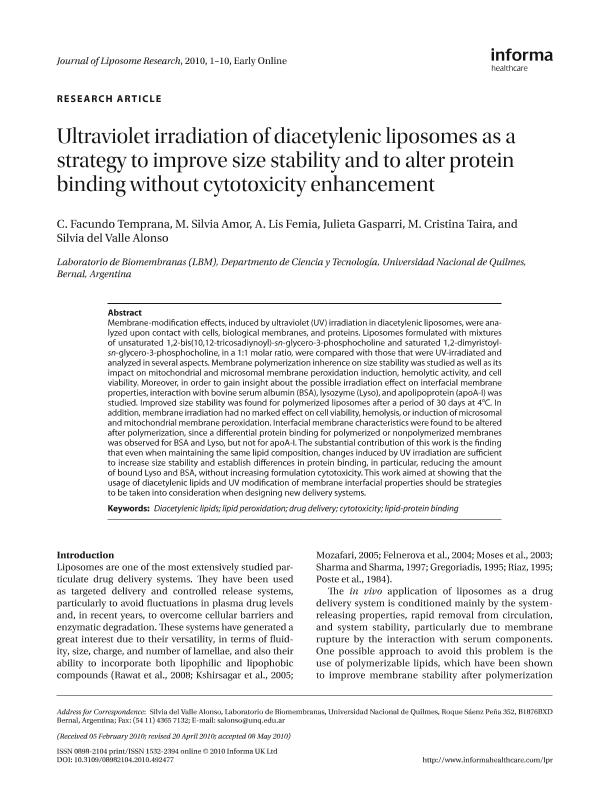Artículo
Ultraviolet irradiation of diacetylenic liposomes as a strategy to improve size stability and to alter protein binding without cytotoxicity enhancement
Temprana, Carlos Facundo ; Amor, M. Silvia; Femia, Lis
; Amor, M. Silvia; Femia, Lis ; Gasparri, Julieta
; Gasparri, Julieta ; Taira, M. Cristina; Alonso, Silvia del Valle
; Taira, M. Cristina; Alonso, Silvia del Valle
 ; Amor, M. Silvia; Femia, Lis
; Amor, M. Silvia; Femia, Lis ; Gasparri, Julieta
; Gasparri, Julieta ; Taira, M. Cristina; Alonso, Silvia del Valle
; Taira, M. Cristina; Alonso, Silvia del Valle
Fecha de publicación:
06/2011
Editorial:
Taylor & Francis
Revista:
Journal Of Liposome Research
ISSN:
0898-2104
e-ISSN:
1532-2394
Idioma:
Inglés
Tipo de recurso:
Artículo publicado
Clasificación temática:
Resumen
Membrane-modification effects, induced by ultraviolet (UV) irradiation in diacetylenic liposomes, were analyzed upon contact with cells, biological membranes, and proteins. Liposomes formulated with mixtures of unsaturated 1,2-bis(10,12-tricosadiynoyl)-sn-glycero-3-phosphocholine and saturated 1,2-dimyristoyl-sn-glycero-3-phosphocholine, in a 1:1 molar ratio, were compared with those that were UV-irradiated and analyzed in several aspects. Membrane polymerization inherence on size stability was studied as well as its impact on mitochondrial and microsomal membrane peroxidation induction, hemolytic activity, and cell viability. Moreover, in order to gain insight about the possible irradiation effect on interfacial membrane properties, interaction with bovine serum albumin (BSA), lysozyme (Lyso), and apolipoprotein (apoA-I) was studied. Improved size stability was found for polymerized liposomes after a period of 30 days at 4°C. In addition, membrane irradiation had no marked effect on cell viability, hemolysis, or induction of microsomal and mitochondrial membrane peroxidation. Interfacial membrane characteristics were found to be altered after polymerization, since a differential protein binding for polymerized or nonpolymerized membranes was observed for BSA and Lyso, but not for apoA-I. The substantial contribution of this work is the finding that even when maintaining the same lipid composition, changes induced by UV irradiation are sufficient to increase size stability and establish differences in protein binding, in particular, reducing the amount of bound Lyso and BSA, without increasing formulation cytotoxicity. This work aimed at showing that the usage of diacetylenic lipids and UV modification of membrane interfacial properties should be strategies to be taken into consideration when designing new delivery systems.
Archivos asociados
Licencia
Identificadores
Colecciones
Articulos(CCT - LA PLATA)
Articulos de CTRO.CIENTIFICO TECNOL.CONICET - LA PLATA
Articulos de CTRO.CIENTIFICO TECNOL.CONICET - LA PLATA
Articulos(IMBICE)
Articulos de INST.MULTIDISCIPL.DE BIOLOGIA CELULAR (I)
Articulos de INST.MULTIDISCIPL.DE BIOLOGIA CELULAR (I)
Articulos(INTEC)
Articulos de INST.DE DES.TECNOL.PARA LA IND.QUIMICA (I)
Articulos de INST.DE DES.TECNOL.PARA LA IND.QUIMICA (I)
Articulos(SEDE CENTRAL)
Articulos de SEDE CENTRAL
Articulos de SEDE CENTRAL
Citación
Temprana, Carlos Facundo; Amor, M. Silvia; Femia, Lis; Gasparri, Julieta; Taira, M. Cristina; et al.; Ultraviolet irradiation of diacetylenic liposomes as a strategy to improve size stability and to alter protein binding without cytotoxicity enhancement; Taylor & Francis; Journal Of Liposome Research; 21; 2; 6-2011; 141-150
Compartir
Altmétricas



